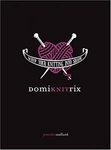 |
All images in this post are from the book and are reproduced here with permission from the author.
When last I blogged, I posted an interview with Jennifer Stafford, the author of the book DomiKNITrix: Whip Your Knitting Into Shape. I hope you'll take the time to read through the interview because it's chock full of great tidbits and suggestions, for the knitter and pattern designer alike.
In this post, I'll be discussing the book itself and my review of it. I am a tough reviewer so expect to hear the good and the bad, as I see it. Take it for what it's worth and take into account your own preference for both learning and knitting, since my taste may differ from yours. The review is rather long, so if you are a skimmer, I suggest jumping ahead to the Conclusion section of this post.
Find the full review, after the jump.
Overview
256 page, soft cover book with color photos. The first 93 pages are devoted to tools, techniques and the author's background. The remainder of the book comprises 18 full patterns, including several with multiple versions. There are also a couple of pages devoted to two projects based on Elfin Goth. These patterns will be available on Stafford's site in the near future.
The entire book is inspired by the mystique of a dominatrix, from the patent leatherlike cover, to the exquisite illustrations, to the double entendres in the section headings and throughout the book. This is not the book to give your 8 year old who wishes to learn to knit, but it will certainly appeal to those who resent the stigma that can sometimes be associated with the title, "knitter."
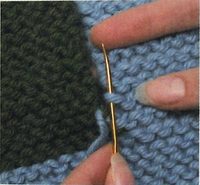 |
| Image from the garter seaming section |
About the tools and techniques section
If you've read the interview you'll know that Stafford's penchant for describing and illustrating technique is what sold the publisher on this book. The tools and technique section will be most valuable to the knitter who has not yet invested in one of the more exhaustive reference books for knitters. She has distilled the techniques down to those that most of us use most often or could benefit from knowing. The more experienced knitter will likely pick up a few good suggestions along the way, if he opts to read the book from cover to cover, for instance, Stafford's notes on installing a zipper or closing the join in circular knitting, may be good tips for even an adept knitter.
What the reader may note is that Stafford has a bias in her choices for technique. Those who are newer or less experienced knitters may come away thinking there is only one way of performing certain techniques. For instance, in the cast-on section, both the long tail and tubular cast-ons differ
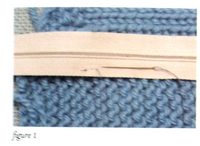 |
| Image from the zipper section |
greatly from the ones I've seen most often here in the US. They may, in fact, be more common in other parts of the world so I will leave that to the reader to decide.
However I don't consider this a shortcoming of the book, but more a limitation of space. I refer back to my comment that there are better resources for those who need comprehensive instruction in knitting technique.What Stafford lacks in variety, she makes up for in clear, easy to understand instruction, with thoughtful comments on how and why she uses each.
The techniques section is not limited to just knitting, it also includes some excellent instructional information about various tools, fibers and care instruction labels. There is certainly enough information contained within these pages to give an astute reader ammunition enough to make an educated choice about yarn substitution and care for the finished project. But most importantly, this section gives the foundation to complete all the patterns contained in the book.
About the patterns
 |
| Snood |
The patterns are organized into three sections; Tasty Morsels (smaller projects), On the Level (more or less employing standard construction), and Side to Side and on the Bias (projects worked with creative construction techniques). The book contains a few relatively simple pieces, though the operative word here is "relatively." The very first project is a scarf worked circularly, to produced a double thickness, non-rolling, stockinette piece. It's all knit, every row, but does ask the knitter to use the two-circular needle technique of knitting in the round, some decreases and, of all things, kitchner stitch. The advantage to this is that an intrepid new knitter will overcome the fear of knitting in the round, before anyone can convince her she should be nervous about it, but to my point, this is not your average "beginner" project. Stafford does a nice job of encouraging the reader to jump in, but this is not likely to be most people's first project.
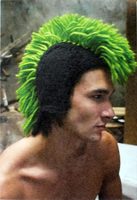 |
| Mohawk |
Overall, I'm really impressed with the suite of designs and think there's something for almost anyone's taste in there. With such wardrobe staples as the City Coat, to an all vegan purse called Home Grown to pieces such as the Diva Halter, best worn by the young and physically fit, the variety of patterns is eclectic, creative and appealing.
As an experienced knitter, I'm not as drawn to some of the simpler projects, such as the above mentioned scarf and the String of Purls, but the Snood and the Mohawk and Snow Devil hats are all projects that really shine amongst the smaller pieces. It's refreshing to see several relatively quick and small projects that also really push the knitter and I suspect that many knitters will enjoy them for the clever construction techniques alone.
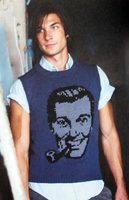 |
| Bob Dobbs Vest |
Amongst the garments, I'm really drawn to the Sweetheart sweater, (an homage to Elsa Schiaparelli's famous trompe l'oeil sweater,) as well as the Bob Dobbs vest for men. Each contains large motifs, but are handled very differently. In both cases, they are cast on circularly and worked in the round for at least some number of rows. But the Sweetheart is divided and worked flat for the intarsia bow, while the vest motif is work entirely in duplicate stitch. In both cases, I'm relatively surprised by the technique choices. I think I'd be more inclined to work the Sweetheart in the round then create the motif with duplicate stitch. This would avoid the change of gauge some people experience going from knitting in the round to knitting flat, often refereed to as "rowing out." On the other hand, I'd probably work the vest flat and in intarsia, reserving the use of duplicate stitch for small detail areas, to avoid the loss of elasticity caused by duplicate stitch, especially over such a large area. However these are personal preferences and it's obvious that the results are stunning regardless of the technique employed.
It's worth noting that the Bralet pattern, in this book, was accidentally photographed inside out. This is truly unfortunate because I was able to see the actual piece in person and there are many lovely little details. Stafford will be posting a new picture on her site, sometime in the near future.
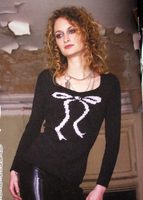 |
| Sweetheart |
For those who have been following Stafford's work for several years, and were anxious to get the pattern for Elfin Goth, do not expect to find the pattern in the book. She has modified the piece into two sister projects titled, Elfin Bride and Gothlet, each of them pullovers employing some or all of the details of the original cardigan. The patterns are not available in the book but will be on her website shortly. I think we can expect some knit-alongs for those patterns, in the not too distant future. The pieces are gorgeous, though, for my own personal body shape, I'd probably migrate the diamond inset up to mid chest, where it would add more weight to that area and draw attention away from the hips. Easier said than done, I suspect, but as each woman's shape is different, I expect will see some creative thinking when it comes time to modify for fit.
Conclusion (AKA, if you don't want to read all my ramblings, you can just read this)
DomiKNITrix: Whip Your Knitting Into Shape is an elegantly balanced mix of technique, advice and unusual and flattering patterns. Stafford's use of dart like shaping will give the skilled knitter many opportunities to refine the fit and achieve great results.
While the list of techniques offered are not exhaustive, everything you need to successfully complete the pieces is contained within and a keen learner will walk away with a better ability to produce lovely pieces on his own.
More advanced knitters make take issue with some of Stafford's choices of technique or construction, but anyone who successfully completes a project is likely to be happy with the end results.
For all the presumptions one might have about a book authored by a self titled "DomiKNITrix" I feel this book exceeds expectation. Aspiring designers will benefit from her creativity and expert construction details, while relatively new knitters will likely be motivated by what they will someday be able to knit. Novices beware, though, even the easy projects will push you to your limits. You'll be well served to make friends with a more skilled knitter or someone at your local yarn shop.
Share this post
Comments (7)
Thanks'Marnie, its a good review of the domiKNITrix book! However, I'd like to post a comment on the section were you question the use of duplicate stitch on a large logo like Bob Dobbs. I did the Bob Dobbs sample for Jennifer and I can assue you that the duplicated logo is elastic. It is a mather of using the technic in the right way; working all rows horizontally. The sweater is really as good as the picture in the book tells you! No need to tell you I'm a big fan of domiKNITrix, almost all items in the book are allready finished!
Posted by miriam tegels | February 27, 2007 1:10 AM
Posted on February 27, 2007 01:10
I saw this book earlier this month when I was checking out knitting books at Borders. I never read her blog b/c I was put off by the blog name, so I thought I wouldn't be into her book either, but as I flipped through the book (and not all projects were to my taste), but I liked what she had to say about fit. I couldn't decide on a book purchase at that time, so I decided to wait. But reading your review really pushed me over to the side of buying this book. I'm sure that I will enjoy having it.
Posted by Wanda | January 27, 2007 12:36 PM
Posted on January 27, 2007 12:36
Thanks for the great review. I'll have to look for that book at my local bookstore and check it out.
By the way, I just watched you on the 80's episode of Knitty Gritty. You were great -- you always give such clear explanations. Now my 10-year old daughter wants me to make her those leg warmers. Hmmm...
Posted by Persnickety Knitter | January 26, 2007 5:53 PM
Posted on January 26, 2007 17:53
I was just at B&N where I saw DomiKNITrix. Took a quick scan through it. Your review is very helpful in trying to decide if I should buy it. Thank you!
Posted by Delica | January 26, 2007 8:43 AM
Posted on January 26, 2007 08:43
Excellent review, Marnie! I definitely want to check this out. That zipper picture alone makes me want to check out the techniques section!
Posted by Carrie | January 26, 2007 6:15 AM
Posted on January 26, 2007 06:15
Your review has convinced me that the book should be in my collection. I love knitting on the bias, but I need more inspiration in using the technique creatively. This sounds like a wonderful source -- and a lot of fun, too. I promise I won't let my children near my copy.
Posted by Roxie | January 26, 2007 5:44 AM
Posted on January 26, 2007 05:44
You wrote a very thoughtful review. i love the bow sweater, and the mohawk hat. Time to check this book out!
Posted by Kat | January 25, 2007 8:43 PM
Posted on January 25, 2007 20:43